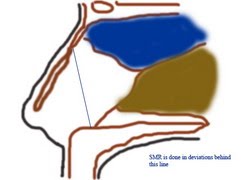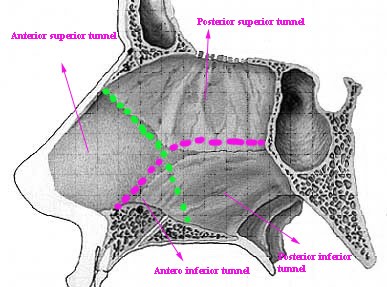Septoplasty
Septoplasty: is defined as a conservative surgical procedure designed to correct anterior septal deviations. (i.e. Deviations anterior to the Cottle's line)
Procedure: This involves 6 phases:
1. Gaining access to the septum
2. Correction of the pathology
3. Removal of the pathology
4. Shaping removed cartilage and bone
5. Reconstruction of septum
6. Stabilizing the septum
Incision:
Freer's Hemitransfixation incision is used to gain access to the nasal septum. This incision is sited 2 mm posterior to the caudal edge of cartilagenous septum.
Anterior tunnel is created between the cartilage and the perichondrium. This anterior tunnel is created on both sides. Sometimes to gain adequate exposure to nasal septum, inferior tunnels need to be created.
In making the inferior tunnels, there is a posterior and anterior approach. The posterior approach is also known as the maxilla - premaxilla approach.
Correction of septal pathology:
If the deviation of the septum is caused by excessive tension to the septal cartilage, it can be corrected by removing an inferior cartilagenous strip. Dislocations due to fractures can be corrected intraseptally by mobilizing or resection of parts of nasal septum.
Removal of septal pathology:
Severe deformities involving the nasal septum may rarely require complete removal of septal cartilage. The resected area is reconstructed using the cartilagenous elements removed from the septum.
Indications for resection include duplications, spines, crests and convexities present in the septum. All the cartilagenous material removed should be saved for reconstruction. The parts of nasal septum that are straight are preserved to support the dorsum, tip and columella of the nose.
Reshaping cartilage and bone:
Reshaping of nasal septal cartilage should be done with as little trauma as possible, with maximum preservation of straight portions of nasal septum. Cartilage does not heal. Fractures and defects of the septal cartilage will be filled with connective tissue. Retraction of connective tissue can alter a good surgical result during the course of healing process. The dynamics of healing process of septal cartilage should be clearly understood before embarking on this step.
Reconstruction of nasal septum: The patients septal cartilage is the most ideal one for nasal septal reconstruction. Other materials like ear cartilage or rib cartilage should be used only as a second choice. Use of septal cartilages from tissue bank can be avoided if possible due to the risk of infections. A strong strip of cartilage under the cartilagenous dorsum of the nose should prevent the formation of saddle nose. Tip projection is preserved by placing a strip of cartilage in the caudal part of nasal septum. This step will also prevent columella retraction in these patients. Small bits of cartilage pieces can be used to fill up a defect in the cartilagenous septum to prevent retraction of nasal soft tissues due to scar formation.
Stabilizing the septum after surgery:
This can be achieved by judicious use of splints, sutures and by packing the nasal cavity with roller gauze. This not only helps to stabilize the septum, but also keeps the mucoperichondrium in contact withe the nasal septum. This is important for the viability of nasal septum.

